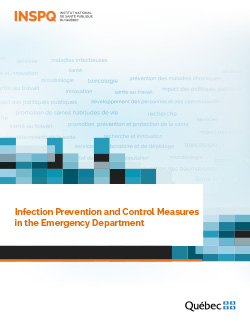Infection Prevention and Control Measures in the Emergency Department
Every year, over 3 million patients, including many cases of transmissible infections, arrive at Québec's emergency departments on foot or by ambulance. In Québec, reference documents are available on emergency department organization and design. However, at present, there are few recommendations for infection prevention and control (IPC) in the literature that focus on practice in an emergency care setting.
This document has been prepared in connection with Action 8 of the Ministère de la Santé et des Services sociaux' (MSSS) Plan d'action sur la prévention et le contrôle des infections nosocomiales 2010-2015 [2010-2015 Action plan for healthcare-associated infections prevention and control]. Its purpose is to make recommendations for IPC in the emergency departments of Québec's hospitals. The recommendations are primarily intended for general and specialized hospital centres. They will have to be adapted according to the facility's mission, the patient population served and various local epidemiological factors.
The recommendations in the document are categorized under the different areas of the emergency department (Appendix 1) and integrate Health Canada's three-tier hierarchy of IPC controls: engineering controls, administrative controls, and personal protective equipment (Appendix 2). Engineering control recommendations should be given priority when constructing new emergency departments or renovating existing emergency departments. An action plan should be developed to ensure these recommendations are integrated into future work.


